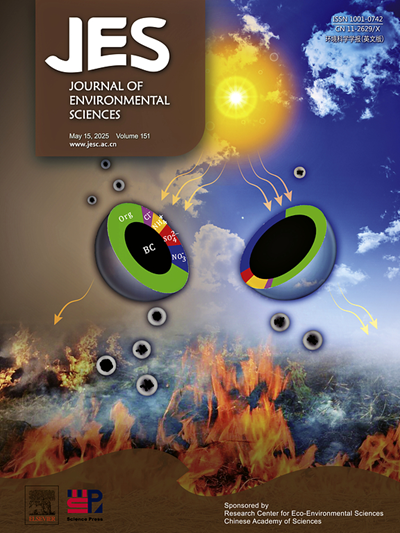Multilevel immobilized CNT/SCN purification beads and the removal efficiency over TCHCl/clay composite pollutant in the underwater environment
IF 5.9
2区 环境科学与生态学
Q1 ENVIRONMENTAL SCIENCES
引用次数: 0
Abstract
Natural water bodies often contain a significant amount of suspended colloidal particles, which not only reduce water transparency but also have a high adsorption capacity for soluble pollutants. These composite pollutants can migrate rapidly with water flow, which are usually difficult to degrade and remove by traditional methods. Aiming at suspended contaminated waterbodies, this study introduced a multilevel loading method to prepare carbon nanotube/sulfur doped carbon nitride (CNT/SCN) composite photocatalytic purification beads. The surface of the obtained core-shell structured purification beads is loaded with CNT/SCN photocatalysts which exhibit three-dimensional conductive and porous characteristics. TC![]() HCl was introduced as the target pollutant, and the removal efficiency of the composite purification beads under different water turbidity and hydrodynamic conditions were investigated. The results showed that during 15 h of degradation process, at the depth of 20 cm, with the flow rate of 0.015 m3/h and water turbidity of 10.3 NTU, the purification beads achieved a removal efficiency of 54.9% for tetracycline hydrochloride (TC
HCl was introduced as the target pollutant, and the removal efficiency of the composite purification beads under different water turbidity and hydrodynamic conditions were investigated. The results showed that during 15 h of degradation process, at the depth of 20 cm, with the flow rate of 0.015 m3/h and water turbidity of 10.3 NTU, the purification beads achieved a removal efficiency of 54.9% for tetracycline hydrochloride (TC![]() HCl), which was 2.03 times higher than that of SCN purification beads. The three-dimensional porous structure of the surface exhibited excellent adsorption and trapping capabilities for suspended colloidal particles. The introduction of carbon nanotubes enhanced charge transfer ability of the surface layer and reduces the local charge accumulation effect caused by surface adsorption, which effectively enhances the adsorption of suspended colloid, and also significantly improved the degradation efficiency of TC
HCl), which was 2.03 times higher than that of SCN purification beads. The three-dimensional porous structure of the surface exhibited excellent adsorption and trapping capabilities for suspended colloidal particles. The introduction of carbon nanotubes enhanced charge transfer ability of the surface layer and reduces the local charge accumulation effect caused by surface adsorption, which effectively enhances the adsorption of suspended colloid, and also significantly improved the degradation efficiency of TC![]() HCl. This study provides a valuable insight for the engineering application of photocatalytic technology.
HCl. This study provides a valuable insight for the engineering application of photocatalytic technology.

多层固定化CNT/SCN净化珠及其对水下环境中TCHCl/粘土复合污染物的去除效果
天然水体中往往含有大量悬浮的胶体颗粒,这不仅降低了水体的透明度,而且对可溶性污染物具有很高的吸附能力。这些复合污染物随水流快速迁移,传统方法难以降解和去除。针对悬浮污染水体,采用多级加载法制备碳纳米管/硫掺杂氮化碳(CNT/SCN)复合光催化净化微珠。所获得的核壳结构纯化珠表面负载CNT/SCN光催化剂,具有三维导电和多孔特性。以TCHCl为目标污染物,考察了复合净化珠在不同水浊度和水动力条件下的去除率。结果表明,在15 h的降解过程中,在深度为20 cm、流速为0.015 m3/h、水浊度为10.3 NTU的条件下,纯化珠对盐酸四环素(TCHCl)的去除率为54.9%,是SCN纯化珠的2.03倍。表面的三维多孔结构对悬浮胶体颗粒表现出优异的吸附和捕获能力。碳纳米管的引入增强了表面层的电荷转移能力,减少了表面吸附引起的局部电荷积累效应,有效增强了悬浮胶体的吸附,也显著提高了TCHCl的降解效率。该研究为光催化技术的工程应用提供了有价值的见解。
本文章由计算机程序翻译,如有差异,请以英文原文为准。
求助全文
约1分钟内获得全文
求助全文
来源期刊

Journal of Environmental Sciences-china
环境科学-环境科学
CiteScore
13.70
自引率
0.00%
发文量
6354
审稿时长
2.6 months
期刊介绍:
The Journal of Environmental Sciences is an international journal started in 1989. The journal is devoted to publish original, peer-reviewed research papers on main aspects of environmental sciences, such as environmental chemistry, environmental biology, ecology, geosciences and environmental physics. Appropriate subjects include basic and applied research on atmospheric, terrestrial and aquatic environments, pollution control and abatement technology, conservation of natural resources, environmental health and toxicology. Announcements of international environmental science meetings and other recent information are also included.
 求助内容:
求助内容: 应助结果提醒方式:
应助结果提醒方式:


